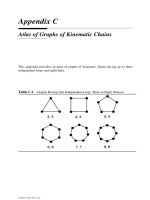Handbook of Lubrication Episode 1 Part 3 pot
Bạn đang xem bản rút gọn của tài liệu. Xem và tải ngay bản đầy đủ của tài liệu tại đây (703.1 KB, 18 trang )
coefficient of friction usually accompanied by a severe rearrangement of surface material
with little loss of material. In most other sliding pairs there is no connection between the
coefficient of friction and wear rate.
Static and Kinetic Friction
The force required to begin sliding is usually greater than the force required to sustain
sliding. For dry surfaces the reason for the starting (or static) coefficient of friction being
larger than the sliding (or kinetic) coefficient of friction may most simply be explained in
terms of the adhesion of asperities. It is often found that the static coefficient of friction
increases with time of standing. This suggests diffusion bonding of the points of contact
which progresses with time. Sustained sliding could be viewed as providing a very short
standing time of one asperity upon another. This should also produce a decrease in the
coefficient of friction as the sliding speed increases, which is found in many systems.
When a hard sphere slides on some plastics, the frictional behavior is such as to require
a new definition of static friction. For example, for a sphere of steel sliding on Nylon 6-6
the coefficient of friction at 60°C varies with sliding speed as shown in Figure 6. The
“static” coefficient of friction is lower than that at v
2
. Most observers would, however,
measure the value of µ at v
2
as the static value of µ. The reason is that v
1
in the present
example is imperceptibly slow. The coefficient of friction at the start of visible sliding at
v
2
is higher than at v
3
. In this case it may be useful to define the starting coefficient of
friction as that at v
2
and the static coefficient of friction as that at or below v
1
.
In lubricated systems the starting friction is often higher than the kinetic friction. When
the surfaces slide, lubricant is dragged into the contact region and separates the surfaces.
This will initially lower the coefficient of friction, but at a still higher sliding speed there
is a viscous drag which again causes an increase in coefficient of friction as shown in Figure
9. This McKee-Petroff curve is typical for a shaft rotated in a sleeve bearing. The abscissa
42CRC Handbook of Lubrication
FIGURE 9.Coefficient of friction pattern for a typical lubricated contact. Z is lubricant vis-
cosity, N′ shaft speed, and P the unit load transferred radially by the shaft to the bearing.
Copyright © 1983 CRC Press LLC
is given in units of ZN′/P where Z is the viscosity of the lubricant, N′ is the shaft rotating
speed, and P is the load transferred radially from the shaft to the bearing.
ROLLING FRICTION
The force required to initiate rolling motion may be larger than the force to maintain
motion if the contacting surfaces are very rough. Sustained rolling motion requires very
little force, usually about 0.01 times that for unlubricated sliding.
There are at least three causes for rolling resistance. The first arises from the strains within
each of the solid bodies in the region of contact. During rolling a point in each body passes
through complex strain cycles; since energy is lost during a cycle of strain in all materials,
energy must be supplied to sustain rolling.
The second reason for rolling friction is due to differences in distortion of the contacting
bodies. This can be seen by pressing the eraser of a pencil into the palm of the hand. During
indentation the skin of the hand stretches, in the contact region as well as outside of it, more
than the eraser increases in size. Thus, there is relative slip between the eraser and the hand.
The same occurs between a ball and flat surfaces and the net effect is that energy is expended
in rolling. The effect of the micro-slip can be decreased by lubrication.
A third reason for rolling friction may be that the rolling bodies are not moving in the
direction of the applied force. A misaligned roller slides axially to some extent and a poorly
guided ball spins about the contact region. Again, lubrication will reduce the energy loss
due to slip.
Frictional resistance of ball and roller bearing assemblies is usually much greater than the
rolling resistance of simple rolling elements because of the cages, grooves, and shoulders
intended to control the travel of the balls or rollers.
Tapping and Jiggling to Reduce Friction
One of the practices in the use of instruments is to tap and/or jiggle to obtain accurate
readings. There are two separate effects. One effect is achieved by tapping the face of a
meter or gage, which may cause the sliding surfaces in the gage to separate momentarily,
reducing friction resistance to zero. The sliding surfaces (shafts in bearings, or racks on
gears) will advance some distance before contact between the surfaces is reestablished.
Continued tapping will allow the surfaces to progress until the force to move the gage parts
is reduced to zero.
Jiggling is best described by using the example of a shaft advanced axially through an
O-ring. Such motion requires the application of a force to overcome friction. Rotation of
the shaft also requires overcoming friction, but rotation reduces the force required to effect
axial motion. In lubricated systems the mechanism may involve the formation of a thick
fluid film between the shaft and the O-ring. In a dry system an explanation may be given
in terms of components of forces. Frictional resistance force usually acts in the exact opposite
direction as the direction of relative motion between sliding surfaces. If the shaft is rotated
at a moderate rate, there will be very little frictional resistance to slow axial motion. In
some apparatus the shaft is rotated in an oscillatory manner to avoid difficulties due to
anisotropic (grooved) frictional behavior. Such oscillatory rotation may be referred to as
jiggling, fiddling, or coaxing.
STICK-SLIP MOTION
Principles of Stick-Slip
Some sliding systems vibrate. Vibration can be a mere annoyance such as the squeal of
automobile brakes or door hinges. Other vibrations serve to notify of abnormal conditions,
Volume II 43
Copyright © 1983 CRC Press LLC
such as in the squeal of automobile tires and unlubricated electric motors. In other instances,
vibration may compromise the function of a machine. In machine tools, surface finish and
shape of final parts are affected by the vibration of tool carriers.
13
Vibration of sliding systems is usually described as stick-slip, frictional vibration, or
frictional oscillation. In the simple model of Figure 10, an object of weight Wis connected
to a prime mover by a spring. As the prime mover moves at constant speed in the direction
shown, the spring stretches until it applies a force to Wthat will initiate sliding. If the
coefficient of friction remains constant after sliding begins, the weight Wwill advance at
the same speed as the prime mover. If on the other hand, the coefficient of friction decreases
after sliding begins, less force will be required to sustain sliding than the spring force.
Weight Wwill, therefore, accelerate, shortening the spring, and finally overshooting the
equilibrium position. The spring then exerts a force less than that required to sustain sliding
so the weight decelerates and may even stop. After deceleration, its velocity is lower than
before and the coefficient of friction may increase. To meet the increased force required to
sustain or reinitiate sliding, the spring must stretch. This produces a never ending cycle with
the weight advancing by a series of fast and slow segments of motion.
An experimental trace of the force exerted by the spring will show interesting differences
depending upon the speed of the prime mover as shown in Figure 11. The upper trace for
slow velocity shows true stick-slip as the force drops to nearly zero as the object comes to
a standstill and the prime mover then advances to stretch the spring once more. In the second
trace where the velocity is moderately high, force variations are smaller and the weight
oscillates between two limiting sliding speeds in frictional oscillation.
In the simplest approach, where the coefficient of friction between the sliding object and
the table is taken to be µ
k
when sliding occurs and µ
s
to start sliding, and where µ
s
> µ
k
,
motion of the weight would follow simple laws of dynamics. Thus, one could reasonably
expect that the frequency of frictional oscillations would be low at low speeds of the prime
mover, with a large weight, and with a flexible or compliant spring. The frictional oscillations
would diminish at high speeds of the prime mover, with small weights and with stiff springs,
producing the lower trace of Figure 11.
It is of great commercial interest to design sliding systems to eliminate or minimize
vibration. In general, the larger the difference (µ
s
– µ
k
), the more likely a system will
oscillate. The transition from µ
s
to µ
k
is influenced by the surface finish of the sliding parts
and by the physical and chemical nature of the lubricant. In general, µ
k
rises as velocity
decreases, as lubricant viscosity increases, as chemical reactivity of lubricant with surfaces
increases, and as surface finish decreases.
13
In machine design it may be possible to stiffen the connection between the prime mover
and sliding object, to reduce the weight of the sliding object, or to provide a thick fluid
film. An additional design consideration is that frictional oscillation can produce pitching
and yawing motion of the moving element if the driving force is applied at a different plane
44CRC Handbook of Lubrication
FIGURE 10.Simplified model of vibrating sliding system.
Copyright © 1983 CRC Press LLC
Table 2
COEFFICIENTS OF STATIC AND SLIDING FRICTION
46 CRC Handbook of Lubrication
Copyright © 1983 CRC Press LLC
Table 2 (continued)
COEFFICIENTS OFSTATIC AND SLIDING FRICTION
Note:Reference letters indicate the lubricant used; numbers in parentheses give sources (see References).
Key to Lubricants Used:
a = oleic acidm = turbine oil (medium mineral)
b = Atlantic spindle oil (light mineral)n = olive oil
c = castor oilp = palmitic acid
d = lard oilq = ricinoleic acid
e = Atlantic spindle oil plus 2% oleic acidr = dry soap
f = medium mineral oils = lard
g = medium mineral oil plus
1
/
2
%oleic acidt = water
h = stearic acidu = rape oil
i = grease (zinc oxide base)v = 3-in-1 oil
j = graphitew = octyl alcohol
k = turbine oil plus 1% graphitex = triolein
l = turbine oil plus 1% stearic acidy = 1%lauric acid in paraffin oil
REFERENCES
(1) Campbell Trans. ASME,1939: (2) Clarke, Lincoln, and Sterrett Proc. API,1935; (3) Beare and Bowden Phil.
Trans. Roy. Soc.,1935; (4) Dokos, Trans. ASME,1946; (5) Boyd and Robertson, Trans. ASME,1945; (6) Sachs,
zeit. f. angew. Math,undMech.,1924; (7) Honda and Yama la, Jour. I. ofM,1925; (8) Tomlinson, Phil. Mag.,
1929; (9) Morin, Acad. Roy. desSciences,1838; (10) Claypoole, Trans. ASME,1943; (11) Tabor, Jour. Applied
Phys.,1945; (12) Eyssen, General Discussion on Lubrication, ASME,1937; (13) Brazier and Holland-Bowyer,
General Discussion on Lubrication, ASME,1937; (14) Burwell, Jour. SAE,1942; (15) Stanton, “Friction”,
Longmans; (16) Ernst and Merchant, Conference on Friction and Surface Finish, M.I.T., 1940; (17) Gongwer,
Conference on Friction and Surface Finish, M.I.T., 1940; (18) Hardy and Bircumshaw, Proc. Roy. Soc.,1925;
(19) Hardy and Hardy, Phil. Mag.,1919; (20) Bowden and Young, Proc. Roy. Soc.,1951; (21) Hardy and
Doubleday, Proc. Roy. Soc.,1923; (22) Bowden and Tabor, “The Friction and Lubrication of Solids”, Oxford;
(23) Shooter, Research,4, 1951.
From StandardHandbookforMechanicalEngineers,7th ed., Baumeister, T., Ed.,McGraw-Hill, New York,
1967. With permission.
about 20% of the midpoint value, averaging must be done with caution. Trace averaging
can be aided by using a parallel plate (noncontacting) viscous damper to diminish oscillations
during tests, as shown in Figure 10.
Volume II 47
Copyright © 1983 CRC Press LLC
TABLES OFCOEFFICIENTOFFRICTION
The coefficient of friction is not an intrinsic property of a material or combinations of
materials. Rather the coefficient of friction varies with changes in humidity, gas pressure,
temperature, sliding speed, and contact pressure. It is different for each lubricant, for each
surface quality, and for each shape of contact region. Furthermore, it changes with time of
rubbing, and with different duty cycles. Very few materials and combinations have been
tested over a wide range of more than three or four variables, and then they are usually
tested in laboratories using simple geometries. Thus, it is rarely realistic to use a general
table of values of coefficient of friction as a source of design data. Information such as that
in Table 2 may provide guidelines,
14
but where a significant investment will be made or
high reliability must be achieved, the friction should be measured using a prototype device
under design conditions.
REFERENCES
1.Bowden, F. E. and Tabor, D.,The Friction and Lubrication of Solids, Oxford University Press, Vols. I
and II, London. 1954 and 1964.
2.Buckley, D. H.,Surface Effects in Adhesion, Wear and Lubrication, Elsevier, Amsterdam, 1981.
3.Barwell, F. T.,Bearing Systems: Principles and Practice, Oxford University Press, London, 1979.
4.Ling, F. F., Klaus, E. E., and Fein, R. S., Eds.,Boundary Lubrication. An Appraisal of World Literature,
American Society of Mechanical Engineers. New York, 1969.
5.Peterson, M. B., Ed.,Wear Control Handbook, American Society of Mechanical Engineers, New York,
1980.
6.Timoshenko, S. and Goodier, J. N.,Theory of Elasticity, 2nd ed., McGraw-Hill, New York, 1951.
7.Greenwood, J. A. and Williamson, J. B. P.,Contact of nominally flat surfaces, Proc. R. Soc. (London),
A295, 300, 1966.
8.Dowson, D.,An interesting account of the life and times of 23 prominent figures in the field of tribology,
J. Lubr. Technol, 99, 382, 1977; J. Lubr. Technol, 100, 2, 1978.
9. Tabor, D., Junction growth in metallic friction, Proc. R. Soc., (London), A251, 378, 1959.
10. Benzing, R., Hopkins, V., Petronio, M., and Villforth, F., Jr., Friction and Wear Devices, 2nd ed.,
Americal Society of Lubrication Engineers, Park Ridge, III., 1976.
11. Ludema, K. C. and Tabor, D., The friction and visco-elastic properties of polymeric solids, Wear, 9,
329, 1966.
12. Yeager, R. W., Tire hydroplaning, in The Physics of Tire Traction, Hayes, D. F. and Browne, A. L.,
Eds., Plenum Press, New York, 1974, 25.
13. Kato, S., Yamaguchi, K., Malsubayashi, T., and Sato, N., Stick-Slip motion and characteristics of
friction in machine tool slideway, Nagoya Univ. 27, 1, 1975.
14. Fuller, D. D., Friction, Marks’ Standard Handbook for Mechanical Engineers, 8th ed., Baumeister, T.,
Ed., McGraw-Hill, New York, 1978.
48 CRC Handbook of Lubrication
Copyright © 1983 CRC Press LLC
BOUNDARYLUBRICATION
Richard S. Fein
CHARACTERISTICS OF BOUNDARYLUBRICATION
Boundary lubrication is defined by OECD as a condition of lubrication in which the friction
and wear between two surfaces in relative motion are determined by the properties of the
surfaces, and the properties of the lubricant other than bulk viscosity. Boundary lubrication
also may be defined in terms of contrast with full-fluid film lubrication where load-bearing
surfaces are completely separated and the load is supported entirely by pressure in the fluid
film.
Usually, boundary lubrication is associated with some load support by interaction of
asperities on the bearing surfaces or of the surfaces with solid particles in the fluid. In the
extreme, asperity and/or panicle interactions support all of the load and friction appears to
be independent of bulk fluid viscosity.
1
Friction and WearPhenomena
Friction and wear under boundary lubrication conditions often approximately obey rather
simple “laws” over considerable ranges of operating and machine configuration conditions.
For friction, the Amonton-Coulomb law states that the coefficient of friction, the ratio of
the friction force to the load, is independent of load and of apparent area of contact.
1
For wear, the volume of material worn from a surface is proportional to the product of
the load and sliding distance divided by the hardness of the material being worn.
2
The
proportionality constant is the “wear coefficient”, k,
(1)
in which v is wear volume, H is hardness, Wis normal load, 1 is distance slid, d is depth
of wear, Pis normal pressure, A
w
is area being worn, and Ais area of apparent load support.
For surfaces which are not in continuous “contact” and the sliding and relative motion are
parallel:
(2)
in which Lis face width of line contact, n is number of passes through load support area,
U is sweep velocity through the area, and U
s
is sliding velocity.
For the more general noncontinuous contact case,
(3)
in which c is width of load support area in the direction of motion and Pis the mean normal
pressure.
Since the wear coefficient, as shown in Table 1, ranges over at least a hundred- to million-
fold range, it is convenient to transform it to the AntiWear Number (AWN) defined as
(4)
Volume II 49
Copyright © 1983 CRC Press LLC
coefficient is relatively constant. Above 13.4 MJ for the straight mineral oil and 161 MJ
for the mild EP oil, the rapid increase in wear corresponds to a wear coefficient about a
hundred times greater than that at low load. Note that strong EP chemical additives increased
the load-carrying capacity over 20-fold.
Operating conditions that produce a transition are commonly expressed in terms of a
“severity parameter”. Common parameters are load P, velocity V, PV, fPV, a measured
temperature in the oil or machine, calculated conjunction temperature for the load support
area, or the reciprocal of the fluid “film thickness parameter” (1/A). These measures all
reflect mechanical or thermal stress. In addition, severity often seems to increase with
decreased lubricant viscosity grade, decreased speed, increased slide-roll ratio (U
s
/U), in-
creased surface hardness, and increased asperity tip curvature (1/r).
Run-In
During initial sliding or rolling between a pair of surfaces, friction and wear coefficients
as well as surface texture change towards a steady-state determined by operating conditions,
the original surface configurations and textures, lubrication, and all other environmental and
material parameters involved. Run-in is crucial since excessive friction and wear or cata-
strophic surface damage are much more likely initially than after the surfaces have reached
a steady state. Effective run-in involves alleviation by wear of misalignment and dimensional
or other errors in geometry, and generates protective surface films that shear and wear
sacrificially and prevent surface damaging transitions.
Volume II 51
FIGURE 2. Effect of load on wear. FZG Gear Test A, 2175 pinion
speed. (Redrawn from Nieman, G., Rettig. H., and Lechner, G., ASLE
Trans., 4, 71, 1961.)
FIGURE 1. Ironing of can wall in two-piece can manufacture.
Copyright © 1983 CRC Press LLC
During run-in, friction and wear coefficients often change approximately exponentially
from beginning values f
b
and k
b
to steady-state values of f
ss
and k
ss
. Instantaneous values at
any sliding distance, ᐉ,tend to follow the equations
(5)
and
(6)
Break-in sliding distance, ᐉ
b
typically may be in the order of a kilometer with an effective
boundary lubricant, negligible load support by a fluid film, and negligible geometric errors
in the sliding parts. This distance for the cylinder liner on a passenger car corresponds to
the order of 1000 km of travel. For a typical spur gear at 30 Hz (1800 rpm) it corresponds
to a day of operation.
Any factor which increases operational severity generally decreases the break-in sliding
distance. Usually, shortest run-ins involve operating conditions as near as is safely possible
to a wear or surface damage transition. As a consequence, run-ins often use low viscosity
oils at low speed and high load. Low speed has the dual effect of increasing severity by
decreasing fluid film formation and of preventing catastrophic frictional heating if a friction
transition is encountered.
Common laboratory load-carrying and friction tests operate in the early stages of run-in
and measure the rapidity of lubricant response to operational severity. By contrast, laboratory
wear tests often are sufficiently long that steady-state conditions are approached.
BOUNDARYLUBRICANTS
Boundary films occur on almost all surfaces because they reduce the surface energy and
are thus thermodynamically favored. Normally, air covers any surface with an oxidized
layer plus adsorbed moisture and organic material. If surfaces slide while covered with a
lubricant film, all elements in the lubricant appear in a chemically reacted boundary film
along with the bearing material elements and atmospheric oxygen. Thicknesses of surface
films may range from tenths of a nanometer (a few hundredths of a microinch) for single
molecular layers of physically adsorbed gases to a few micrometers (several dozen mi-
croinches) for thick chemically reacted boundary films from oils with EPadditives.
Gases
Inadvertent lubrication by air is the most common boundary lubrication. Among com-
ponents listed in Table 2, oxygen and/or water vapor are necessary for satisfactory dry sliding
of most metal surfaces. Without their adsorption and/or chemical reaction films, catastrophic
levels of friction, wear, and surface damage usually occur. Hydrocarbons are also generally
helpful.
A gaseous component is capable of covering the surface with a monolayer in about 1/
(concentration, ppb) sec. Thus, oxygen alone could cover a clean surface in about 5 nsec
(1/0.209 × 10
9
ppb), while sulfur dioxide alone would require about a second. Nitrogen mole-
cules generally do not stick well to a clean surface. With clean air, the first molecular layer
formed on a clean metal surface would be expected to have a composition approximating
the distribution of the strongly adsorbing/reacting components.
52 CRC Handbook of Lubrication
Copyright © 1983 CRC Press LLC
Figure 3 shows that aromatic and olefinic hydrocarbons give better wear protection in air
than paraffinic and naphthenic hydrocarbons of comparable viscosity (comparable molecular
size). For comparable hydrocarbon type, higher viscosity (larger molecule) hydrocarbons
give better wear protection even under boundary lubrication conditions.
Additives
Additives that adsorb at surfaces generally contain both base-oil and surface-attracting
portions as illustrated in Figure 4. Molecules of this type cluster in “micelles” with their
surface attracting portions on the interior and oil-solubilizing portions on the exterior. These
54 CRC Handbook of Lubrication
FIGURE 3. Effect of hydrocarbon type and viscosity on wear. Four-
ball machine, 50-kg load, 3.5 mm/sec, 15 to 16 hr at 38°C. P, N, O,
and A indicate paraffinic, naphthenic (i.e., cycloparaffinic), olefinic,
and aromatic, respectively.
FIGURE 4. Example of chemical compounds used as boundary lu-
bricant additives.
Copyright © 1983 CRC Press LLC
additives may be considered as “dispersed” in the oil rather than being dissolved. Inorganic
solid lubricants can also be made to form stable dispersions in oil by making the particles
sufficiently small and covering their surfaces with oil-solubilizing chemical groups.
Additives may be classified functionally as lubricity, antiwear, and extreme-pressure.
Lubricity additives reduce and smooth friction — particularly at low sliding speeds. Antiwear
additives, as the name implies, reduce wear. EPadditives extend the loads that can be
covered without a transition to unacceptably high friction, wear, or surface damage.
The same additive can perform more than one function. Thus, a zinc dithiophosphate,
such as shown in Figure 4, is both an antiwear and an EPadditive. This combination of
antiwear and EPfunctionality is common. The combination of oiliness and antiwear also
commonly occurs. By contrast, a combination of oiliness and extreme-pressure functionality
is rare.
Lubricity additive molecules generally contain unbranched chains of carbon atoms that
are at least ten atoms in length, plus at least one surface attracting group. The unbranched
chains sometimes are only part of one or more oil-solubilizing groups. Antiwear and lubricity
additives often increase load-carrying capacity over that of a neat base oil.
EPadditive molecules usually contain phosphorous, sulfur, or chlorine and also may
contain oxygen, lead, zinc, boron, etc. EPadditive effects are most evident at high tem-
peratures: under conditions of high sliding velocity, high and concentrated loads, and high
bulk temperatures.
EPadditives, as illustrated in Figure 5, usually decrease wear under conditions less severe
than the lowest transition (“initial seizure” load in four-ball testing). Also, EPadditives
most often control wear and surface damage at loads above the lowest transition. In many
cases, this permits satisfactory performance of mechanisms such as gears above the transition
Volume II55
FIGURE 5.Schematic four-ball load-capacity data. Four-ball ma-
chine, 690 mm/sec, 10 sec, room temperature. Arrows on curves in-
dicate weld load. A, B, and C indicate indifferent, moderately active
EP, and active EP lubricants, respectively.
Copyright © 1983 CRC Press LLC
for part of their life. EPagents also commonly increase the severity of conditions required
to produce failure by catastrophically rapid wear, surface damage, or “welding”.
Boundary lubricant additives interact with base oils, with each other, with atmospheric
gases and water, and with thermal and oxidative degradation products of lubricants. Table
3 illustrates interactions between the lubricity additive, behenic acid, and an antiwear/EP
additive, zinc diisopropyldithiophosphate. The lubricity additive enhances the wear protec-
tion and lowest transition load over that with zinc diisopropyldithiophosphate alone. How-
ever, at the highest concentration, the additive interferes with the ability of the EPadditive
to prevent catastrophic wear and surface damage (scuffing) at the highest load. Incidentally,
tendency for wear protection to increase with load below the lowest transition load is often
observed with antiwear additives. In most cases, increasing severity by increasing surface
roughness decreases load-carrying capacity. However, the reverse is true for the last two
EPadditives listed in Table 4.
5
Surface Films
Cumulative evidence indicates that lubricity additives provide lubrication by covering each
of the sliding surfaces with a thick film of molecules. These films can be formed from
additives with molecular shapes that preclude close packing of the hydrocarbon chains.
Lastly, typical lubricity additives can give chemically complex reaction products, at least
for steel surfaces.
6,7
Similarly, EPadditives produce complex organic material-containing surface films in
contrast to the widely held view that they give simple inorganic films (e.g., iron sulfide
from an active sulfur EPadditive). Films formed from neat base oils and oiliness or EP-
additive oils all contain each chemical element present in the bearing metal and the lubricant
as well as oxygen from ambient air.
6,7
The films generally contain organic and inorganic
materials present as both chemically bound (soaps) and physical mixtures. EPfilms are
generally solid-like, and contain the order of the same number of organic carbon and oxygen
atoms as they do iron atoms.
6
Generally, hydrocarbons give predominantly organic reaction products when wear is low
and inorganic products when wear is high. The organic materials are polymeric, partially
oxidized, metal-soap-containing material. The inorganic portion from steel generally contains
iron oxides. Lubricity additives generally give organic complex metal-soap-containing films
under low-wear conditions. Films from both hydrocarbons and additives usually appear to
be liquid-like dispersions of chemical reaction products and bulk lubricant.
Films from all types of lubricants seem to become thicker, more oxidized, more inorganic,
and more solid-like as operating conditions become more severe and as the sliding distance
increases. Films tend to be more solid-like and inorganic close to the substrate surface and
more like the bulk lubricant farthest from the substrate.
BOUNDARYLUBRICATION MECHANISMS
Asperities and Load-Bearing Characteristics
Surfaces have gently sloping hills or asperities that are large compared to molecular
dimensions. These asperities range upwards in height a few orders of magnitude from
approximately 10 nm (i.e., about
1
/
2
μin.) for the smoothest engineering surfaces. Slopes
on the sides of asperities range from the order of a degree upwards to 30° on roughly finished
bearing surfaces.
When two bearing surfaces of the same material are brought together as illustrated in
Figure 6, they initially “touch” at the highest asperities. The size of the real contact area
may be readily calculated if the asperities are sufficiently high and steep that the pressure
at contact points causes permanent deformation. In this case, the asperities yield until pressure
in the contact areas just equals the asperity plastic flow strength:
56 CRC Handbook of Lubrication
Copyright © 1983 CRC Press LLC
Theapproximately Gaussian height distribution of asperities allows definition of the
surface separations at which asperities carry load. In terms of the RMS (root mean square)
surface roughness, σ, asperities must bear some load when the mean surface separation
becomes less than about 2σto 4σ. To aid understanding of boundary lubrication phenomena,
the following will be restricted to the extreme case in which asperities provide all the load
support.
Boundary Film Friction
Ingeneral, boundary friction consists of two components, a shear or adhesion component
and a plowing or deformation component.
1
Considering Figure 7, shear component, F
s
,
predominates except when asperities sink too deeply into a boundary lubricant film or a soft
opposing surface. When sliding occurs, the shear friction force depends on the shear re-
sistance per unit area, S, of any “boundary film” in the real load-supporting area between
asperities.
(10)
Dividing by load, W, gives the shear contribution to the friction coefficient. Note that this
becomes independent of total load and apparent area of contact.
(11)
Traditionally the boundary film shear resistance, S, has been assumed equal to the plastic
flow shear stress, τ
p
, of an ideal elastic, plastic solid.
1
Such a solid gives shear stress
independent of strain (and strain rate) at strains sufficiently large to cause plastic flow. This
traditional picture did not explain how Newtonian liquid lubricants give friction coefficients
similar to those of organic solids.
Recent research
8
provided the unifying picture of flow properties shown in Figure 8.
Materials such as mineral oils that approximate ideal liquids at atmospheric pressure and
common shear rates can act like plastic solids at the high pressures and shear rates between
sliding asperities. The conditions that produce the “glass transition” from liquid to plastic-
like behavior are strongly dependent on the viscosity of the material at normal temperatures
and pressures and the variation of viscosity with temperature and pressure. Thus, glass
transition depends strongly on chemical composition.
Volume II59
FIGURE 7.Boundary film formation and shear.
Copyright © 1983 CRC Press LLC
lubrication situations. For a plastic solid boundary film, the plastic flow stress, τ
p
, rather
than the viscous shear stress is responsible for film entrainment.
WEAR MECHANISMS
When surfaces slide under boundary lubrication conditions, wear seems to be produced
by the four following principal mechanisms acting alone and in combination: corrosion,
fatigue, abrasion, and adhesion.
Corrosive wear— Occurs when bearing surface material chemically reacts with its
environment to form a boundary film containing some bearing material and the film material
becomes detached from the surface. Examples of corrosion boundary films are (1) metal
oxide formed from oxygen or water in the air or lubricant, and (2) soaps of fatty acids and
other salts formed by reaction with a lubricant additive or with lubricant oxidation products.
If the films are pushed aside rather than entering the real load-supporting zones between
asperities or dissolve in the bulk lubricant, then corrosive wear occurs. Corrosive wear also
occurs if the film spalls from the surface in the load-supporting zones.
Fatigue wear— Involves fracture of asperities or film material from repeated high stress.
Commonly, this wear mechanism is evidenced by micropitting in rolling element bearings.
In sliding bearings, observation of fatigue wear of asperities is usually obscured by abrasion,
denting, and adhesion produced by trapping of the spalled particles between the surfaces.
Asperity fatigue probably is an important mechanism at least during the early stages of run-
in and severe adhesive wear.
Abrasive wear— Occurs when a hard sharp asperity (such as on a file) or a third body
(such as a spalled asperity or a dust particle) plows a furrow through a surface. Evidence
that it occurs is found as an occasional microchip wear particle such as shown in Figure 9.
This chip was obtained under nominally well-lubricated and nonabrasive sliding (AWN
above 7 and no known hard or sharp asperities or particles). Abrasion can also lead to
indirect wear. As illustrated in Figure 10, plastic deformation creates ridges on either side
of a plowed groove. The ridges represent new sharp asperities which tend to preferentially
fatigue from the surface.
Adhesion— Is the mechanism of wear mentioned most frequently as the primary process
in review articles and reference works. Particles which are removed from one surface are
either permanently or temporarily attached to the other surface by solid-phase welding. It
is the author’s belief that adhesion is likely a secondary mechanism in boundary lubrication
because of the difficulty of achieving the proper conditions.
6
High vacuum studies show
that surfaces must be atomically clean and within atomic distances of each other to adhere
strongly. Further, atomically clean surfaces are extremely difficult to obtain except by
generation of fresh surface via plastic extension. Hence, under effective lubrication condi-
tions, adhesion of material from one bearing surface to the other surface probably results
from plowing. This would be expected when a trapped third body, such as a fatigued asperity
wear particle, is deformed plastically at the same time that confining bearing surfaces are
being deformed plastically. This extends the surface films on both the wear particle and the
Volume II61
FIGURE 9.Microchip wear particle from effective lubrication under
sliding.
Copyright © 1983 CRC Press LLC
carrying zones between interacting asperities. If the film is liquid, the amount of entrainment
will depend on viscosity. If the film is solid, elastic-plastic resistance to deformation will
determine the entrainment. Whether liquid or solid, the film can protect surfaces only if it
deforms coherently. If the film breaks and exposes substrate, those exposed areas will have
substantially reduced protection.
As previously discussed, additives, many base oils, and some antiwear additives (under
mild conditions) likely give boundary films that are much more viscous than the bulk
lubricant.
6
Cushioning
Table 6 gives elastic moduli for solid materials that encompass compositions of boundary
films and most bearing materials. Inorganic glasses are chemically similar to metal oxides
while organic glasses and rubbers are similar to low-metal-content organic boundary lubricant
films found in sliding systems. Solid-like boundary films with low moduli would be expected
to reduce elastic stresses on high modulus asperity tips when film thickness approaches the
diameter of the load-carrying zone of an asperity contact. The size scales in Table 5 suggest
that such cushioning can be important with the thickest boundary films such as those formed
by EPlubricants.
Figure 11 illustrates the cushioning effect of a low-modulus (high compliance) film.
Compared to Figure 7, the thick compliant film rather than the substrate surface is deformed
and the stresses on the substrate are thereby reduced.
Volume II63
FIGURE 11.Cushioning of asperities.
Table 6
ELASTIC MODULI OF
BEARING AND FILM-LIKE
MATERIALS
Copyright © 1983 CRC Press LLC
Thermal Insulation
Table 7 indicates that boundary films consisting of iron oxides and hydrocarbons should
be thermal insulators compared to substrate bearing metals.
6
With viscous heating of the
hydrodynamic (or ehd) film, this insulation from the substrate metal will raise the film
temperature, decrease film viscosity, and thus lower friction. Such insulating effects become
important when boundary film thickness approaches the hydrodynamic (or ehd) film thick-
ness.
12
Table 5 indicates that all but the thinnest boundary films should be capable of reducing
friction of at least some ehd films. The thickest boundary films may similarly affect friction
of the thinnest hydrodynamic films.
Boundary films also appear capable of reducing friction due to shearing of micro-rhd films
between asperities. For this to occur, the part of the boundary film closer to the substrate
must be much more shear-resistant than that farther from the surface. This often seems to
be the case: the film closest to the substrate is thickened by inorganic substrate elements
while that farther away is more like the bulk lubricant. Decreased frictional heating also
increases the viscosity of the bulk lubricant with a consequently thicker ehd or hydrodynamic
film. The reduction in substrate bearing temperatures also increases entrainment tendencies
of the boundary film. The increase in surface separation reduces stresses on asperities and,
thus, damage by fatigue or plastic deformation. Increased entrainment of boundary films
also reduces the corrosive wear that occurs when boundary film (which contains reacted
substrate metal) is removed from the surface by forces that push it aside in entrance regions
to macro- and microconjunctions.
Coherence and Friability
Approach of bearing metal surfaces to atomic dimensions over sufficiently large areas of
welding to occur seems to require considerable extension of the surfaces. Extension thins a
boundary film and brings nascent metal to the surface-film interface. This nascent metal
interacts with similar nascent metal unless its chemical bonding tendency is satisfied by the
availability of boundary film material (including gases). Maximum extension before exposure
of nascent metal occurs when the superposed boundary films do not fracture as they thin.
Thus, the boundary films can protect against welding of the surfaces by thinning coherently
in addition to reducing surface stresses. Probably this coherence is enhanced by the organic
components that are an integral part of solid-like EPfilms.
Once a weld has been produced, the extent of surface damage will be minimized if the
welded material is friable. If brittle and the resultant fragments are small, plastically de-
forming welds break at an early stage of deformation. Friability can be caused by surface
films which inhibit emergence of dislocations from the surface. Oxide films cause embrit-
tlement. An active sulfur EPoil has similarily been shown to embrittle steel.
11
Oxygen,
water, and at least some EPadditives likely reduce severe surface damage by making asperity-
to-asperity and asperity-to-particle welds friable.
6
64CRC Handbook of Lubrication
Table 7
THERMAL CONDUCTIVITY
OF STEEL AND FILM
COMPONENTS
Copyright © 1983 CRC Press LLC
On the other hand, lubricity additives such as fatty acids make metals less brittle because
they remove dislocation-locking oxide films. This effect probably partially explains why
oiliness additives often enhance severe surface damage. The effect is also a partial explanation
of the beneficial effects of oiliness additives in metal processing where large surface exten-
sions are necessary.
SELECTION OF BOUNDARY LUBRICANTS
Need for a boundary lubricant may be indicated by any of the dimensionless factors listed
in Table 8. The interaction factor,
9,10
thermal factors,
13
and required wear life
14
usually can
be calculated from machine geometry and operating conditions using available formulas
such as Equations 1 to 4. Friction requirements generally can be calculated from design
considerations. Limiting thermal parameters are available for various machine element and
surface combinations.
14-17
Occasionally different lubricant/atmosphere combinations are in-
cluded in these tabulations. Similarily, tabulations of representative wear coefficients are
available
14
for calculation of expected wear life.
Various factors associated with the boundary lubrication requirement are given in Table
9. Values above threshold levels in the left-hand two columns lead to increasing needs for
Volume II 65
Table 8
DIMENSIONLESS FACTORS FOR ESTIMATING
BOUNDARY LUBRICATION REQUIREMENTS
a
Significant factor only when surface separation by ehd or hydrodynamic film is less
than about 5 µm (200 µ in.).
Table 9
ESTIMATED EFFECT OF FACTORS ON BOUNDARY
LUBRICATION REQUIREMENT
a
Difficult only with high thermal factor.
Copyright © 1983 CRC Press LLC









